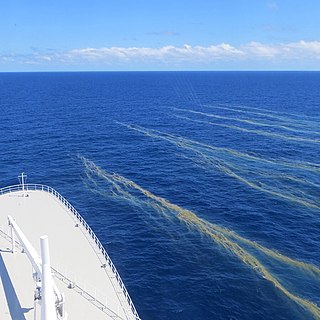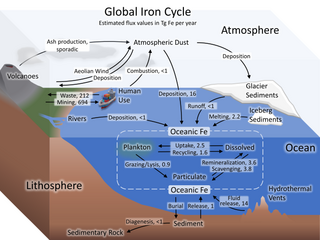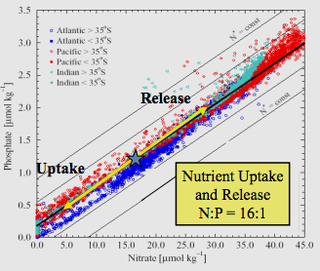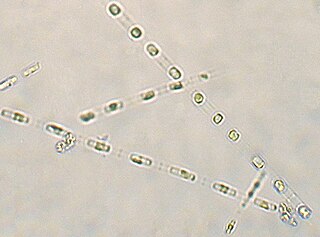Related Research Articles

An algal bloom or algae bloom is a rapid increase or accumulation in the population of algae in freshwater or marine water systems. It is often recognized by the discoloration in the water from the algae's pigments. The term algae encompasses many types of aquatic photosynthetic organisms, both macroscopic multicellular organisms like seaweed and microscopic unicellular organisms like cyanobacteria. Algal bloom commonly refers to the rapid growth of microscopic unicellular algae, not macroscopic algae. An example of a macroscopic algal bloom is a kelp forest.

Phytoplankton are the autotrophic (self-feeding) components of the plankton community and a key part of ocean and freshwater ecosystems. The name comes from the Greek words φυτόν, meaning 'plant', and πλαγκτός, meaning 'wanderer' or 'drifter'.

Trichodesmium, also called sea sawdust, is a genus of filamentous cyanobacteria. They are found in nutrient poor tropical and subtropical ocean waters. Trichodesmium is a diazotroph; that is, it fixes atmospheric nitrogen into ammonium, a nutrient used by other organisms. Trichodesmium is thought to fix nitrogen on such a scale that it accounts for almost half of the nitrogen fixation in marine systems globally. Trichodesmium is the only known diazotroph able to fix nitrogen in daylight under aerobic conditions without the use of heterocysts.

The iron cycle (Fe) is the biogeochemical cycle of iron through the atmosphere, hydrosphere, biosphere and lithosphere. While Fe is highly abundant in the Earth's crust, it is less common in oxygenated surface waters. Iron is a key micronutrient in primary productivity, and a limiting nutrient in the Southern ocean, eastern equatorial Pacific, and the subarctic Pacific referred to as High-Nutrient, Low-Chlorophyll (HNLC) regions of the ocean.

The Redfield ratio or Redfield stoichiometry is the consistent atomic ratio of carbon, nitrogen and phosphorus found in marine phytoplankton and throughout the deep oceans.

The phosphorus cycle is the biogeochemical cycle that describes the movement of phosphorus through the lithosphere, hydrosphere, and biosphere. Unlike many other biogeochemical cycles, the atmosphere does not play a significant role in the movement of phosphorus, because phosphorus and phosphorus-based compounds are usually solids at the typical ranges of temperature and pressure found on Earth. The production of phosphine gas occurs in only specialized, local conditions. Therefore, the phosphorus cycle should be viewed from whole Earth system and then specifically focused on the cycle in terrestrial and aquatic systems.
The deep chlorophyll maximum (DCM), also called the subsurface chlorophyll maximum, is the region below the surface of water with the maximum concentration of chlorophyll. The DCM generally exists at the same depth as the nutricline, the region of the ocean where the greatest change in the nutrient concentration occurs with depth.

Bacterioplankton refers to the bacterial component of the plankton that drifts in the water column. The name comes from the Ancient Greek word πλανκτος, meaning "wanderer" or "drifter", and bacterium, a Latin term coined in the 19th century by Christian Gottfried Ehrenberg. They are found in both seawater and freshwater.

Ditylum brightwellii is a species of cosmopolitan marine centric diatoms. It is a unicellular photosynthetic autotroph that has the ability to divide rapidly and contribute to spring phytoplankton blooms.

Crocosphaera watsonii is an isolate of a species of unicellular diazotrophic marine cyanobacteria which represent less than 0.1% of the marine microbial population. They thrive in offshore, open-ocean oligotrophic regions where the waters are warmer than 24 degrees Celsius. Crocosphaera watsonii cell density can exceed 1,000 cells per milliliter within the euphotic zone; however, their growth may be limited by the concentration of phosphorus. Crocosphaera watsonii are able to contribute to the oceanic carbon and nitrogen budgets in tropical oceans due to their size, abundance, and rapid growth rate. Crocosphaera watsonii are unicellular nitrogen fixers that fix atmospheric nitrogen to ammonia during the night and contribute to new nitrogen in the oceans. They are a major source of nitrogen to open-ocean systems. Nitrogen fixation is important in the oceans as it not only allows phytoplankton to continue growing when nitrogen and ammonium are in very low supply but it also replenishes other forms of nitrogen, thus fertilizing the ocean and allowing more phytoplankton growth.
Trichodesmium thiebautii is a cyanobacteria that is often found in open oceans of tropical and subtropical regions and is known to be a contributor to large oceanic surface blooms. This microbial species is a diazotroph, meaning it fixes nitrogen gas (N2), but it does so without the use of heterocysts. T. thiebautii is able to simultaneously perform oxygenic photosynthesis. T. thiebautii was discovered in 1892 by M.A. Gomont. T. thiebautii are important for nutrient cycling in marine habitats because of their ability to fix N2, a limiting nutrient in ocean ecosystems.

Thalassiosira is a genus of centric diatoms, comprising over 100 marine and freshwater species. It is a diverse group of photosynthetic eukaryotes that make up a vital part of marine and freshwater ecosystems, in which they are key primary producers and essential for carbon cycling
Benjamin Van Mooy is an oceanographer and senior scientist at the Woods Hole Oceanographic Institution located in Woods Hole, MA. His work primarily focuses on chemical oceanography, with a particular focus on the production and remineralization of marine organic matter.
Richelia is a genus of nitrogen-fixing, filamentous, heterocystous and cyanobacteria. It contains the single species Richelia intracellularis. They exist as both free-living organisms as well as symbionts within potentially up to 13 diatoms distributed throughout the global ocean. As a symbiont, Richelia can associate epiphytically and as endosymbionts within the periplasmic space between the cell membrane and cell wall of diatoms.
Mary Jane Perry is an American oceanographer known for the use of optics to study marine phytoplankton.
Patricia Marguerite Glibert is marine scientist known for her research on nutrient use by phytoplankton and harmful algal blooms in Chesapeake Bay. She is an elected fellow of the American Association for the Advancement of Science.

Tatiana Rynearson is an American oceanographer who is a professor at the University of Rhode Island. Her research considers plankton diversity and abundance. Rynearson has been on several research cruises, including trips to the North Sea, Puget Sound, the Gulf of Mexico and the North Atlantic.

Curtis A. Suttle is a Canadian microbiologist and oceanographer who is a faculty member at the University of British Columbia. Suttle is a Distinguished University Professor who holds appointments in Earth & Ocean Sciences, Botany, Microbiology & Immunology and the Institute for the Oceans and Fisheries and a Fellow of the Royal Society of Canada. On 29 December, 2021 he was named to the Order of Canada. His research is focused on the ecology of viruses in marine systems as well as other natural environments.

Skeletonema costatum is a cosmopolitan centric diatom that belongs to the genus Skeletonema. It was first described by R. K. Greville, who originally named it Melosira costata, in 1866. It was later renamed by Cleve in 1873 and was more narrowly defined by Zingone et al. and Sarno et al. Skeletonemacostatum is the most well known species of the genus Skeletonema and is often one of the dominant species responsible for red tide events.
Susanne Menden-Deuer is an oceanographer and marine scientist known for her work on marine food webs, including their structure and function. As of 2022, she is president-elect of the Association for the Sciences of Limnology and Oceanography.
References
- 1 2 Stern, Carly (2020-03-09). "The Scientist Tackling the Ocean Food Chain". OZY. Archived from the original on 2021-12-24. Retrieved 2021-07-28.
- 1 2 "Sonya Dyhrman Named Fellow of the American Academy of Microbiology". State of the Planet. 7 February 2019. Retrieved 28 July 2021.
- 1 2 Dyhrman, Sonya T (1999). Cellular markers of phosphate stress in phytoplankton. OCLC 1086373412 . Retrieved 28 July 2021.
- ↑ "Sonya Dyhrman - Staff Profiles - The Earth Institute - Columbia University". www.earth.columbia.edu. Retrieved 2021-07-28.
- 1 2 3 "Sonya Dyhrman". Simons Foundation. 2014-10-05. Retrieved 2021-07-28.
- ↑ Dyhrman, Sonya T.; Palenik, Brian P. (1997). "The Identification and Purification of a Cell-Surface Alkaline Phosphatase from the Dinoflagellate Prorocentrum Minimum (dinophyceae)1". Journal of Phycology. 33 (4): 602–612. doi:10.1111/j.0022-3646.1997.00602.x. ISSN 1529-8817. S2CID 84642849.
- ↑ Dyhrman, Sonya T.; Palenik, Brian (1999). "Phosphate Stress in Cultures and Field Populations of the Dinoflagellate Prorocentrum minimum Detected by a Single-Cell Alkaline Phosphatase Assay". Applied and Environmental Microbiology. 65 (7): 3205–3212. Bibcode:1999ApEnM..65.3205D. doi:10.1128/aem.65.7.3205-3212.1999. PMC 91475 . PMID 10388722.
- ↑ Ruttenberg, Kathleen C.; Dyhrman, Sonya T. (2005). "Temporal and spatial variability of dissolved organic and inorganic phosphorus, and metrics of phosphorus bioavailability in an upwelling-dominated coastal system". Journal of Geophysical Research: Oceans. 110 (C10). Bibcode:2005JGRC..11010S13R. doi:10.1029/2004JC002837. hdl: 1912/3687 . ISSN 2156-2202.
- ↑ Martin, P.; Dyhrman, S. T.; Lomas, M. W.; Poulton, N. J.; Van Mooy, B. A. S. (2014-04-21). "Accumulation and enhanced cycling of polyphosphate by Sargasso Sea plankton in response to low phosphorus". Proceedings of the National Academy of Sciences. 111 (22): 8089–8094. Bibcode:2014PNAS..111.8089M. doi: 10.1073/pnas.1321719111 . ISSN 0027-8424. PMC 4050623 . PMID 24753593.
- ↑ Dyhrman, Sonya T.; Benitez-Nelson, Claudia R.; Orchard, Elizabeth D.; Haley, Sheean T.; Pellechia, Perry J. (2009). "A microbial source of phosphonates in oligotrophic marine systems". Nature Geoscience. 2 (10): 696–699. Bibcode:2009NatGe...2..696D. doi:10.1038/ngeo639. ISSN 1752-0908.
- ↑ Dyhrman, Sonya T.; Webb, Eric A.; Anderson, Donald M.; Moffett, James W.; Waterbury, John B. (2002). "Cell-specific detection of phosphorus stress in Trichodesmium from the Western North Atlantic". Limnology and Oceanography. 47 (6): 1832–1836. Bibcode:2002LimOc..47.1832S. doi: 10.4319/lo.2002.47.6.1832 . ISSN 1939-5590.
- ↑ Dyhrman, S. T.; Chappell, P. D.; Haley, S. T.; Moffett, J. W.; Orchard, E. D.; Waterbury, J. B.; Webb, E. A. (January 2006). "Phosphonate utilization by the globally important marine diazotroph Trichodesmium". Nature. 439 (7072): 68–71. Bibcode:2006Natur.439...68D. doi:10.1038/nature04203. ISSN 1476-4687. PMID 16397497. S2CID 4409898.
- ↑ "Ocean's hidden fertilizer: Marine plants play major role in phosphorus cycling". phys.org. May 14, 2015. Retrieved 2021-07-28.
- ↑ Dyhrman, Sonya T.; Jenkins, Bethany D.; Rynearson, Tatiana A.; Saito, Mak A.; Mercier, Melissa L.; Alexander, Harriet; Whitney, LeAnn P.; Drzewianowski, Andrea; Bulygin, Vladimir V.; Bertrand, Erin M.; Wu, Zhijin (2012-03-29). "The Transcriptome and Proteome of the Diatom Thalassiosira pseudonana Reveal a Diverse Phosphorus Stress Response". PLOS ONE. 7 (3): e33768. Bibcode:2012PLoSO...733768D. doi: 10.1371/journal.pone.0033768 . ISSN 1932-6203. PMC 3315573 . PMID 22479440.
- ↑ Alexander, Harriet; Jenkins, Bethany D.; Rynearson, Tatiana A.; Dyhrman, Sonya T. (2015-04-13). "Metatranscriptome analyses indicate resource partitioning between diatoms in the field". Proceedings of the National Academy of Sciences. 112 (17): E2182–E2190. Bibcode:2015PNAS..112E2182A. doi: 10.1073/pnas.1421993112 . ISSN 0027-8424. PMC 4418864 . PMID 25870299.
- ↑ "Coexisting in a sea of competition: Similar diatom species seek out nutrients in different ways". phys.org. April 13, 2015. Retrieved 2021-07-28.
- ↑ Dyhrman, Sonya T.; Haley, Sheean T. (2006). "Phosphorus Scavenging in the Unicellular Marine Diazotroph Crocosphaera watsonii". Applied and Environmental Microbiology. 72 (2): 1452–1458. Bibcode:2006ApEnM..72.1452D. doi:10.1128/aem.72.2.1452-1458.2006. PMC 1392970 . PMID 16461699.
- ↑ Dyhrman, Sonya T.; Haley, Sheean T.; Borchert, Jerry A.; Lona, Bob; Kollars, Nicole; Erdner, Deana L. (2010). "Parallel Analyses of Alexandrium catenella Cell Concentrations and Shellfish Toxicity in the Puget Sound". Applied and Environmental Microbiology. 76 (14): 4647–4654. Bibcode:2010ApEnM..76.4647D. doi:10.1128/aem.03095-09. PMC 2901750 . PMID 20495054.
- ↑ Wurch, Louie L.; Haley, Sheean T.; Orchard, Elizabeth D.; Gobler, Christopher J.; Dyhrman, Sonya T. (2011). "Nutrient-regulated transcriptional responses in the brown tide-forming alga Aureococcus anophagefferens". Environmental Microbiology. 13 (2): 468–481. doi:10.1111/j.1462-2920.2010.02351.x. ISSN 1462-2920. PMC 3282463 . PMID 20880332.
- ↑ "Sonya Dyhrman". www.nasonline.org. Retrieved 28 July 2021.